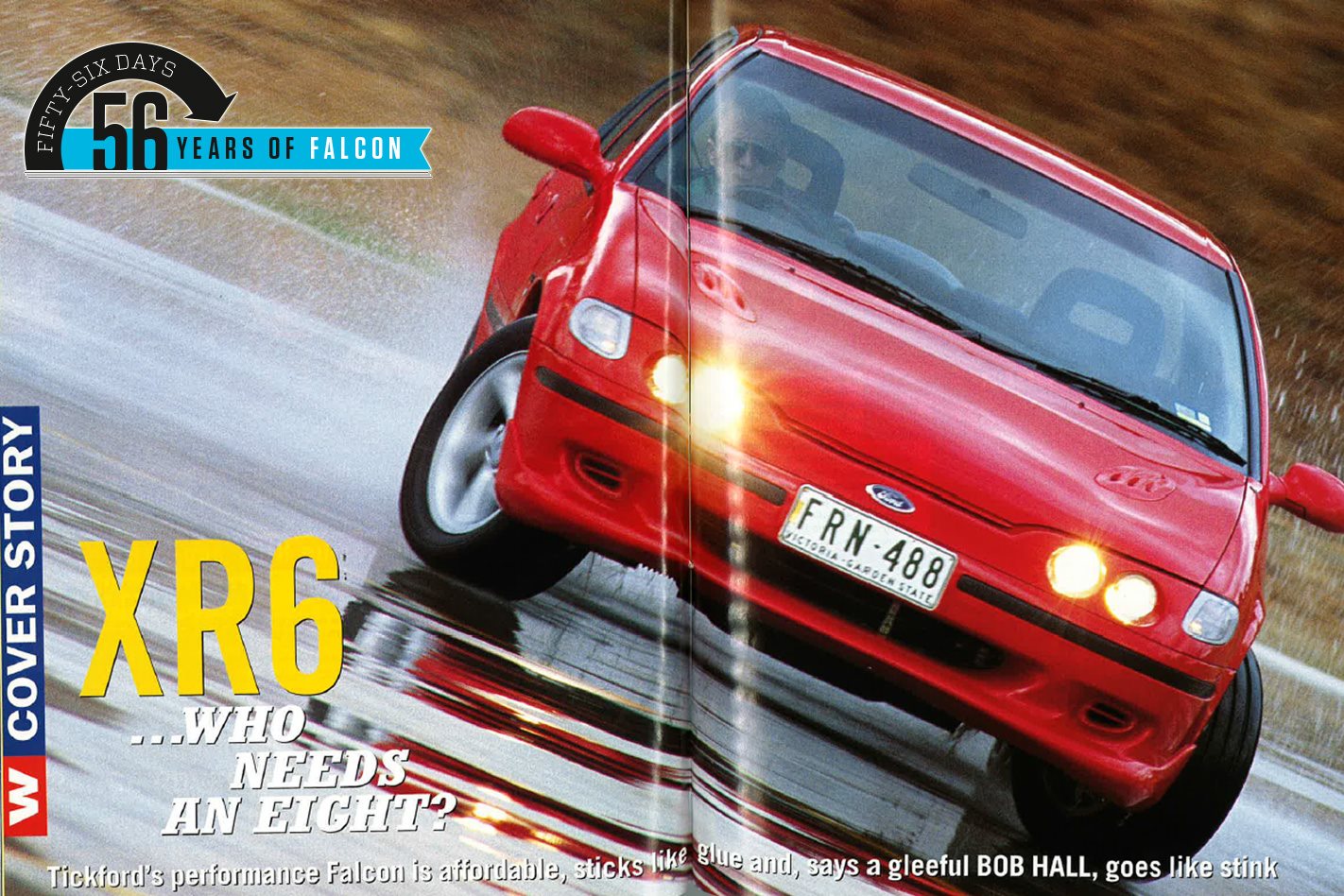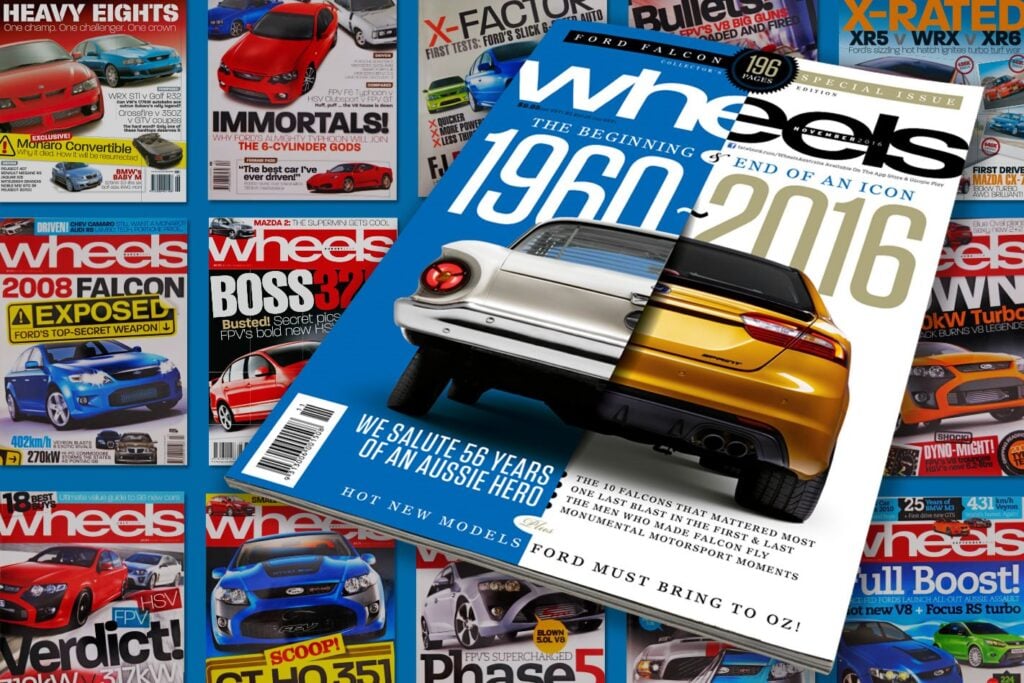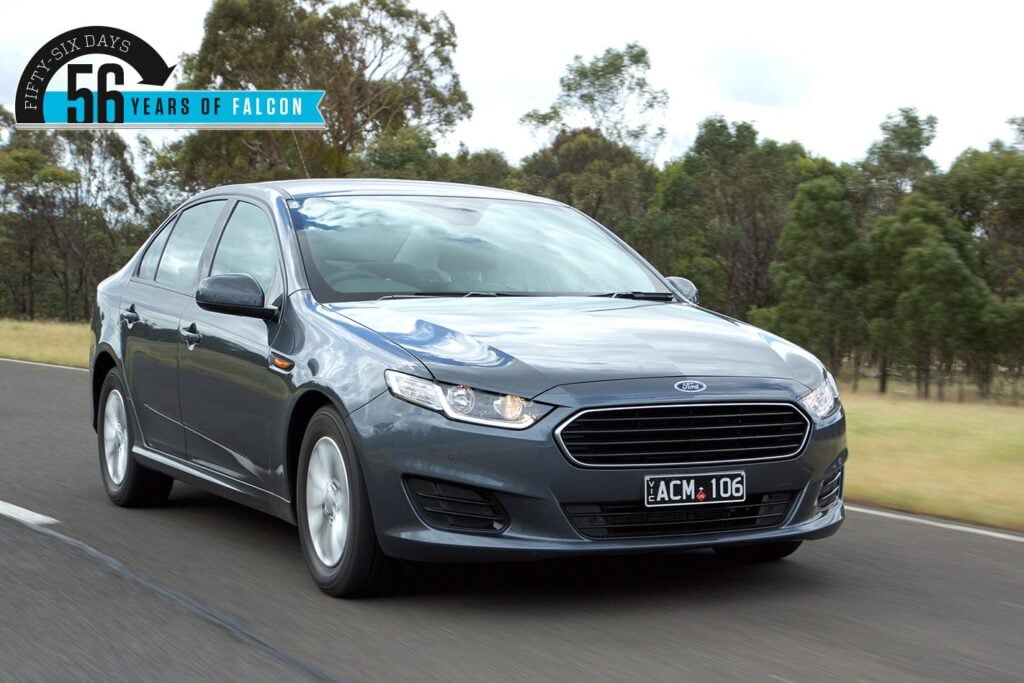First published in the October 1994 issue of Wheels magazine, Australia’s best car mag since 1953.
Tickford’s performance Falcon is affordable, sticks like glue and, says a gleeful Bob Hall, goes like stink.
This may be a vintage year for Australian performance cars. Autumn saw the anything-for-a-rush HSV GTS 215i, the 5.7-litre Commodore – now Spring roars in with Ford’s substantial re-do of the already hot XR6!
Let’s not beat about the bush: the new XR6 may be the best balanced and best volume car to ever come from an Australian manufacturer at an affordable price. It goes like stink, handles delightfully and won’t eat you out of house and home while doing it.
It is faster than HSV’s 185i Clubsport and its own V8 brothers, the XR8 and limited-run XR8 Sprint.
Since its introduction in October 1992, the Falcon XR6 has become a fixture in the Australian carpark. Now in its third iteration, the success of Ford’s muscular six-pot has even outpaced the greatest expectations of the Broadmeadows boys.
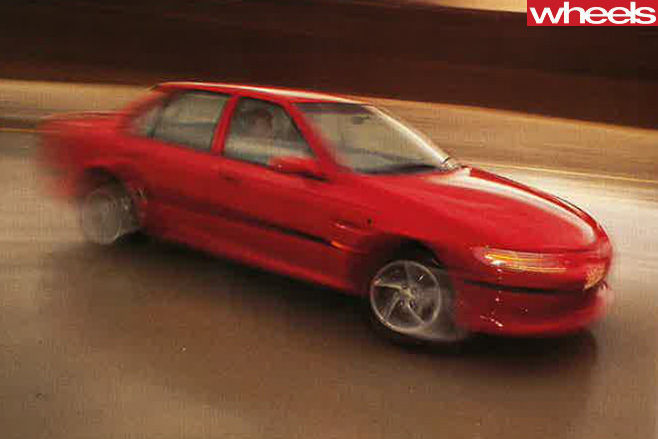
Tickford Vehicle Engineering’s massage of the XR6 sedan and wagon as well as the XR8 sedan has genuinely improved the breed. The only bad news concerns the two seater – the Blackwood-derived XR6 ute is essentially unchanged (new wheels are on offer).
Of course the HSV 215i’s impressive performance – it sprints from stop to 100 clicks in 6.6 seconds and covers a standing start 400 metres in 14.8 seconds – comes with an impressive price tag, around $60,000.
The bent-eight brigade may never wear a mere six as a substitute for an eight, but Tickford’s XR6 is there for the currency-challenged to whom performance counts more than a roll-call of cylinders. After all, the latest EF version of the XR6 starts at a mere $34,584, spare change for HSV owners and very attractive when they learn that the XR6 reaches 100 kays in 7.5 seconds and covers the standing 400 metres in 15.5.
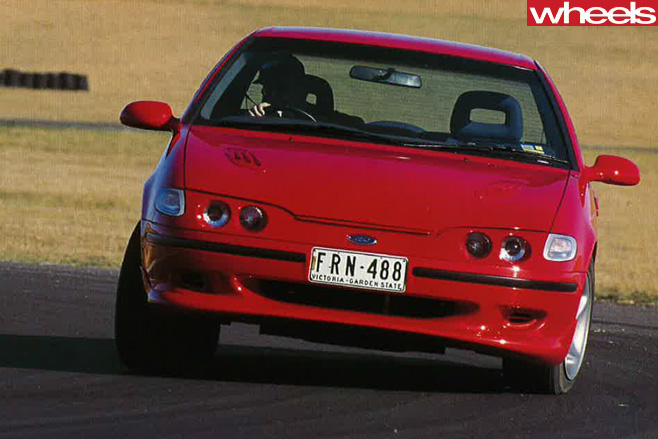
This succinctly describes Tickford’s way of doing things. Unlike some of the German tuning shops, Tickford is more interested in developing a car with a balance of performance the owner can use and appreciate… which is probably why Tickford Falcons lack gold badges, 21-inch wheels and twin-scroll turbos.
In lieu of forced induction, the engine development team at Tickford headquarters in Milton Keynes UK (there’s a little cred for import fanciers) took a long hard look at the EF’s revised 4.0 litre in-line six and went to work improving output within realistic cost targets.
Perhaps the most notable (but least apparent) change is the increase in exhaust valve size. When the valve size was increased from 39 to 41 mm there was an opportunity (and need) to do some housekeeping in the port itself, so gas flow was improved considerably.
Removal of some material when the combustion chambers get reprofiled also necessitates milling the head to bring the compression ratio up to near that of the regular 4.0 six (9.3:1 for the standard 157 kW engine, 9.35:1 for the XRs). Valve springs were given a five per cent higher pre-load than standard. When all is said and done, improving the XR6’s engine has created gas flow to rival the best Japanese multi-valve four cylinder engines.
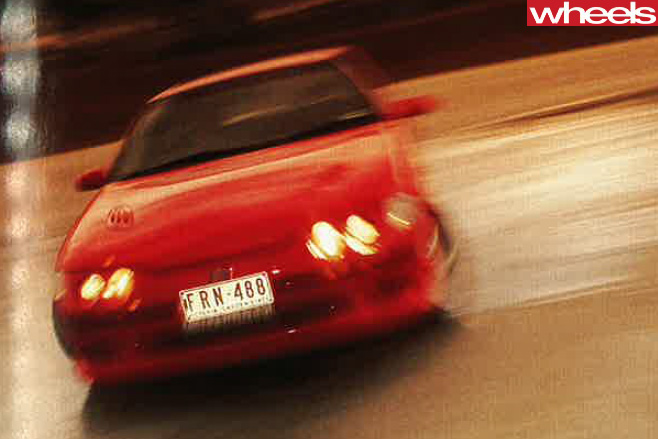
Considering how good some BMW two valve sixes are, that’s high praise indeed. With a new camshaft optimising valve lift and operation, cooler plugs, recalibration of the knock sensor and alteration of ignition andd fuel curves through the EEC-V control system (the EEC-V limits top speed of automatic sedans and all wagons, by the way), the end results are awfully impressive: 164 kW at 5000 rpm and 366 Nm at 3000 rpm.
But there’s more to the figures than the numbers alone: the torque curve’s flatter than the Nullarbor – between 2750 and 3500 rpm, torque ranges from a ‘low’ of 365 Nm to a ‘high’ of 366 Nm! – and the transmission ratios of the five speed box use that torque. Taking the car to redline in each gear will put you smack in the middle of the torque curve when you change up into the next gear.
Driveability is eye-opening, particularly if you’ve been driving buzzy 16 valve fours.
The transmission hasn’t been messed with. Borg-Warner’s evergreen T5 carries on without alteration. The optional four speed automatic has had the shift algorithms altered to provide faster shifts at higher rpm when the transmission is in the normal mode; economy mode shift characteristics are unchanged. The automatic now has lock-up in third, enhancing throttle control and performance over tighter roads with a reduction in hunting and shifting, something perhaps best appreciated on unpaved surfaces.
The six has a neat, meaty exhaust snarl and tends to make all the right noises, though it is noticeably thrummier than the low(er) output six in regular EFs. Whether it’s due to additional sound deadening in the nonsporting models, the XR6’s manual transmission rather than the automatic in all the EFs we’ve driven so far, or the tuning of the XR’s spunky six, we were mindful of it.
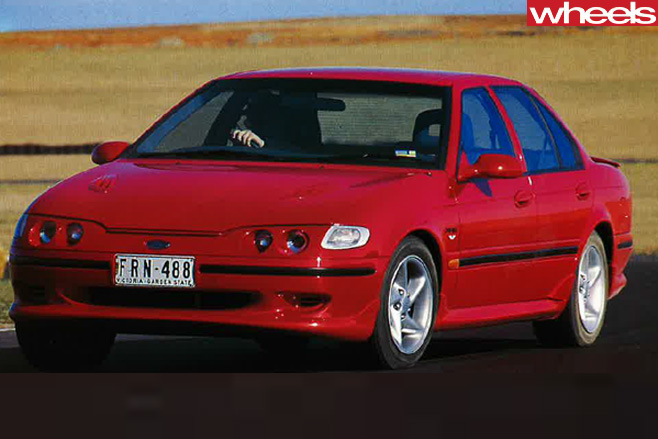
Previously, the XR8 shared its prime mover with the rest of the range, but positioning a 165 kW V8 against a 164 kW six might be, er, difficult. The V8 is imported assembled, limiting Tickford’s modifications, but still it extracts an additional 5 kW (to 170 at 4500 rpm) and torque by 10 Nm (398 at 3000 rpm). A larger air intake snorkel and lower restriction exhaust system provide the gains: The XR8’s manual gearbox – making it the only current Falcon with an eight and a
manual transmission – is also carried over, though the final drive ratio has been raised from 3.27:1 to 3.23:1 (that of the automatic has been lowered to 3.45:1).
The XR8 automatic now benefits from slicker shifting protocols lifted straight from the XR8 Sprint automatic.
The already well pinned down chassis of the XR6 has been finessed to provide improvement in ride without compromising the car’s handling, and on the whole Tickford has met these disparate goals –Japanese manufacturers take note.
The front spring rates on all XRs are softer up front. Front coils have had their rate lowered from 69 N/mm to 66 N/mm which is still almost a third firmer than those found in regular EFs.
The XR sedans and wagons ride 23 mm lower than GLi, Futura and Fairmont.
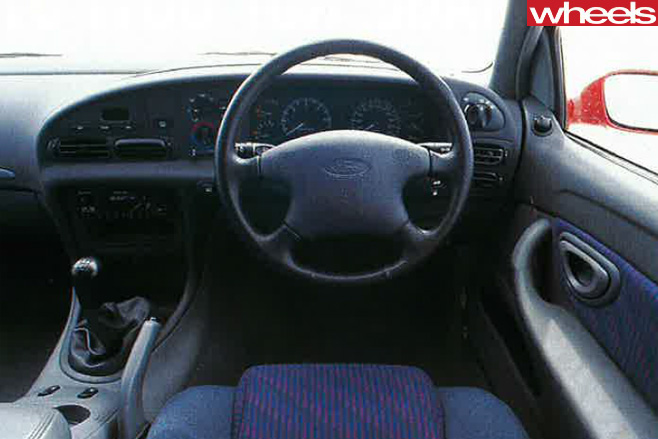
Tickford is also using a progressive rate rubber bushing at the front with a washer which provides better control and less deformation during high G loadings. There’s also an extra degree of caster in the XR front suspension relative to the base Falcons and Fairmonts, as well as 0.75 degree less camber and two degrees more toe-in.
The rear geometry of the XRs differs notably from that of the regular EF sedans, with relocated front pivots for the upper longitudinal locating arms. The two main reasons for this were as a method of reducing noise from the differential (which, thanks to the reduced ride height, sits closer to the cabin) and, more importantly, to control roll oversteer.
When Ford began using the 27mm front anti-roll bar on the EF range, it inadvertently cranked in a touch of roll oversteer which accounts for the EF’s slightly twitchy feel after quick turn-in.
With the rear suspension mods to the XRs, this twitchiness has been purged, so the XR6 has greater stability without the EF’s occasional “here comes the rear end” feel.
Crisp and linear turn-in hasn’t been sacrificed in the process. With the front and rear suspension mods, the chassis balance of the XR6 is awfully good, even on unpaved surfaces.
Dearborn would be proud of the car’s road manners. Good one, Tickford!
The standard XR tyre and wheel combination is a set of 15 x 7Jcast alloy wheels with 205/65VR15 Michelin MXVs. Optional for all XR sedans and wagons are Michelin Pilot XGT Vs in hefty 225/ 50VR16 size – on even meaner looking wheels. They aren’t exactly cheap at $2048, but they sure look good. Oh, and they make the XR6 stick like a limpet slathered with superglue. The ride doesn’t deteriorate too badly with the low profile rubber, either.
As with straightline performance, there is indeed a handling difference between the XR6 and XR8. Adhesion is virtually identical to the XR6, though the eight has a somewhat vague, slightly sloppier feel. This manifests itself most prominently in transient response which is distinctly duller than the 30 kg lighter six cylinder car.
The braking system is one of the few places the car hasn’t been changed, and considering how well the EF’s stoppers work, that isn’t at all bad. And the centre-pull handbrake is an even more welcome addition here than it was in the newly-released EFs.
Reasonably crisp and direct, the power steering is lifted straight from the rest of the Falcon range, and works well with the chassis enhancements. The low mass of Ford’s airbag steering wheel is a real benefit in the XRs, even if it does look dorky with a black leather rim that matches little else in the interior save the shift knob, radio bezel and instrument faces.
Other than the potential for some cloud making from the tyre-blistering performance, the most overt differences the man on the street will spot are the cosmetic ones, and they are numerous.
The quad-lamp theme continues, but in an all-new, and dramatic, form. The new XR snout races forward with an aggressive sweep that appears as a smooth continuation of the EF’s sloping bonnet line.
As with the rest of the EF range, the XRs are ‘bottom-breathers’, but unlike the Falcon range, there is not even the hint of a step between the bumper bar and the leading edge of the bonnet – the facia-cum-headlamp surround rolls straight to the top of the bumper.
The effect is pretty dramatic and, we suspect, polarising. It seems as though a big hunk of the market research for the original XR6 which said the target buyers wanted a car that was “distinctive but not outrageous” has been left by the wayside. A reservation about the styling: some “Wheels staffers think the extreme nose treatment may age quickly.
Time will tell.
The XR sedans and wagons use the bonnet pressing of the Falcon series with a pair of air extractor outlets mounted roughly midway. They are more subtle than those we saw on the limited-edition Falcon GT, but they still stir a bit of controversy in the Ford and Tickford organisations. We like ’em, but they mightn’t be everyone’s cup of hemlock.
The XR identity carries on with the cherry red inserts in the bumpers and bodyside moulding (which are colour-keyed to the body now) on all but red cars, which get black inserts.
Two things you notice: the inserts are considerably taller, and as a result more extroverted than those of previous XRS; the cherry red is an acquired taste when mixed with some body colours. The restricted XR colour palette continues: red, white, cobalt blue, Polynesian green and black. People who like washing their cars hourly should queue now for a black one, as the colour is scheduled to be replaced shortly by an anthracite metallic.
The XR6 we used for testing was fitted with the $2098 body styling kit which consists of bodyside sill, front spoiler and rear skirt extensions, all offered on Falcons and Fairmonts as well as XR8 sedans. Like the rear bumper on all EFs, the rear extension has a knock-out for a towbar. At “Wheels the
jury’s out on the styling kit, though we lean slightly towards the idea that the money might be best spent on the 16 inch wheel and tyre combo.
At the rear, the decklid lip spoiler of previous XRs has been replaced by a rear wing, complete with LED high-mount brake light. The wing was originally to be a Fairmont Ghia part to provide series differentiation between the two Fairmonts!
Better it ends up here…
Between the four-eyed nose and the bewinged butt is the cabin where, beyond the previously mentioned black leather steering wheel, the only other deviations are the EF seats, the standard power front windows and the sedan’s optional $839 CD changer. Like the Falcon GLi, you can get any interior colour you want, so long as it is Lunar Mist (though the snazzoid seat fabrics are exclusive to the XRs).
So if you haven’t already gotten the idea, the XR6 is even better than the car we raved about two years ago, and it isn’t only because it has a proper handbrake now.
Tickford has both impressively built upon the improvements Ford brought to the table with the new EF series, and moved into new territory.
The six’s output comes close to its 170 kW limit thanks to the combination of Ford’s new 12-counterweight crankshaft and variable length inlet runners and Tickford’s optimisation expertise, yet it has greater driveability than before.
Disregarding the chassis improvements on both cars, the strength of the XR6 puts the validity of its big brother XR8 in doubt.
Ford’s US-built 5.0 litre pushrod V8 is rumoured to be heading for retirement – it’s already been replaced in most US passenger car applications by Ford’s expensive Modular OHC V8, and trucks will follow shortly.
Now that a six performs better than the eight in virtually every area, and has superior fuel economy and crisper, more sure-footed handling, the question is – who needs the eight anymore?

